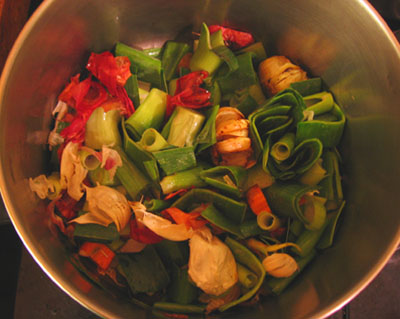So. Many. Potatoes. Normally this would be a good thing, but because I can’t seem to find a place in my house to store the darn things without them going bad asap, I need to keep them (along with my onions and garlic) in my fridge. And those babies take up a lot of room. So I’ve been struggling to keep up with the constant summer influx of potatoes. As much as I like potatoes, they differ from other overabundant CSA veggies in one critical way. I can eat an entire bunch of kale or two pounds of zucchini or head of lettuce on my own in a single sitting and feel quite smug about how many servings of my daily vegetable requirement I’ve just downed.
But eating a couple of pounds of potatoes on my own feels over the top. I’m not a huge subscriber to the empty-carbs-evil-carbs perspective, but that many potatoes feels like a giant wallop of glycemic-spiking starchy calories. Much as I learned during my cauliflower revelations, potatoes are probably actually incredibly healthy, especially with the skins still on, but I still prefer to eat them in moderation.
Another thing taking up an absurd amount of room in my fridge was a leek from a few weeks back. This single leek was so long it fit across almost the entire width of my refrigerator! I’m doing a slow-cooker cookbook exploration this week and came across a recipe for a vegan gratin of potatoes. That sounded interesting because it’s a way to use up a ton of potatoes at once but then dole them out slowly as a small side dish, but doing it in a slow cooker seemed unnecessary when I could just make them in the oven. (Making them in the slow cooker does eliminate the need to precook the potatoes, but this recipe is so delicious I think it’s worth the extra step, though I can’t say for sure having never tried the crock pot version.)
So, using the “cheese” sauce from The Vegan Slow Cooker and a Gruyere-filled potato and leek gratin recipe from Vegetarian Cooking for Everyone for inspiration, I whipped up something pretty delicious. It’s a bit bland and quite rich, but I think that’s just what a gratin is intended to be. There are some lovely garlicky notes and thyme is the standout seasoning, which is something I really enjoy.
Vegan Potato and Leek Gratin
With inspiration from The Vegan Slow Cooker and Vegetarian Cooking for Everyone
Cheese sauce:
1 C. cashews, soaked
1 C. nutritional yeast
5 cloves garlic
1 t. sea salt
1.5 C. almond milk
3 lb red potatoes, unpeeled, thinly sliced
1 giant leek or 2 regular leeks, white parts only, thinly sliced into half moons
1 quart almond milk (or more if needed)
2 t. dried thyme or 3 sprigs fresh thyme
3 garlic cloves, thinly sliced
2 t. salt
Fresh grated nutmeg
Fresh ground black pepper
Garlic and vegan butter for the dish
Heat oven to 375. Run a cut clove of garlic thoroughly over the inside of a large gratin dish (this usually refers to an oval casserole dish – you’ll need either a deep one like I used in the photos above or a very large one, 9×12-ish, or you can just use a regular casserole pan – but if you do, beware of spillage in the oven!). Butter generously.
In a large pot combine potatoes, leeks, milk, thyme, garlic, and salt. Make sure potatoes are at least barely covered by the milk. Bring slowly to a boil, then simmer gently until potatoes are barely tender but not falling apart.
While potatoes are simmering, blend sauce ingredients in a blender until smooth.
Drain potatoes RESERVING THE MILK or you can use a slotted spoon to lift out as many as you need at a time.
Put a single layer (roughly, doesn’t have to be perfect) of potatoes in the bottom of the dish. Sprinkle with nutmeg and pepper. Top with some of the cheese sauce. The way I did this was to pour a thick line of cheese sauce from the blender down the middle of the dish and then use a fork to gently push it across all the potatoes. It’s a very thick sauce and easy to spread. Continue layering potatoes, nutmeg & pepper, and cheese sauce until there are no more potatoes. Top with cheese sauce. Take the reserved milk and, carefully pushing the potato mixture away from the wall of the dish, pour in a little bit so it runs down through all the layers. Repeat this on all four sides of the dish. You want the milk to come up to the level of the potatoes, but they will probably be quite wet and saturated already so add in your milk carefully.
(Any leftover milk can be saved as a base for soup. Or you can do what I did – I poured my leftover milk, with potato and leek bits, into the blender that still had residue of my cheese sauce and blended it all together. It turned into a pretty amazing cream of potato soup.)
Bake the gratin in the oven, an hour or more, until a bubbly brown crust forms on top. Let sit for ten minutes and serve warm.














